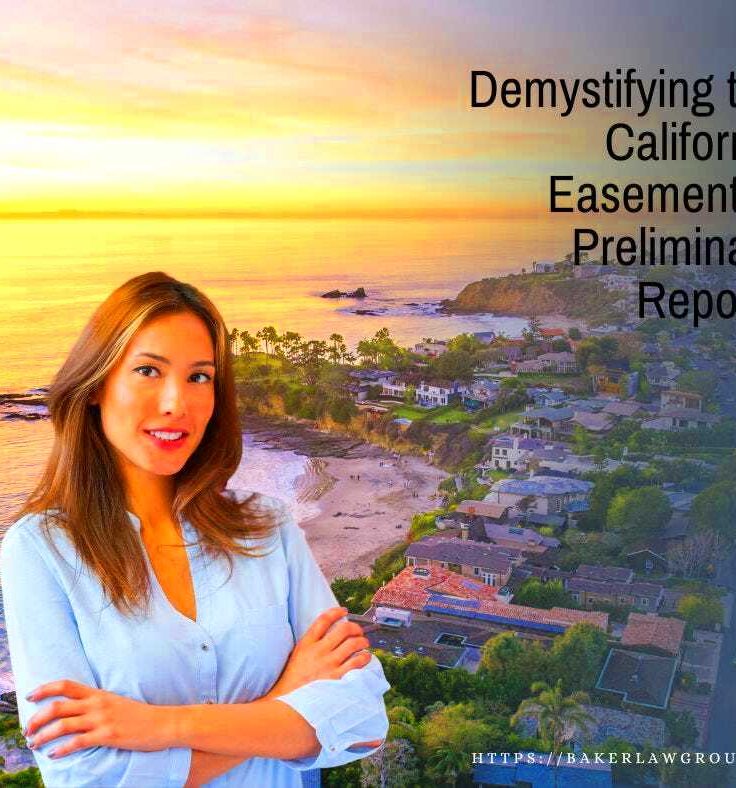Key Points About California Easement Law
Easements are a common feature in California’s property law, granting one party the right to use another’s land for a specific purpose. Whether it’s for accessing a road or using shared utilities, easements play a key role in property management and rights. Understanding these laws helps property owners and land users avoid disputes and ensure they are acting within their legal rights.
In this section, we’ll explore what easements are, how they function in California, and why it’s important to know your rights and obligations when dealing with them.
Types of Easements in California

There are several types of easements in California, each serving different purposes and carrying specific rights. Knowing the distinctions is crucial to understanding the legal framework behind each easement.
1. Prescriptive Easement
This type of easement is acquired through continuous and open use of someone else’s land without permission. After a certain period, the person using the land may gain legal rights to continue doing so.
2. Easement by Necessity
An easement by necessity occurs when a property is landlocked, and the owner must cross another’s land to access a public road. This is typically granted when no other reasonable access is available.
3. Utility Easement
This easement allows utility companies to install and maintain infrastructure such as water pipes, electrical lines, or gas pipelines on private property. These easements ensure essential services reach all areas.
4. Express Easement
An express easement is created through a written agreement between two parties, clearly stating the terms, use, and purpose of the easement.
5. Easement in Gross
This type is personal to an individual or organization and is not tied to a specific piece of land. For example, a utility company may have the right to place power lines over various properties.
How Easements Are Created
Easements can be established in several ways, each with specific legal processes and requirements. Knowing how an easement is created helps clarify the legal standing of both the property owner and the easement holder.
1. By Agreement
The most common way to create an easement is through a written agreement between the property owner and the person who will use the easement. This agreement is usually recorded with the county to make it legally binding.
2. By Prescription
A prescriptive easement is created when someone openly uses another’s land for a continuous period, typically five years or more in California, without the owner’s permission. The user gains legal rights to continue using the land in the same manner.
3. By Necessity
If a property owner has no access to a public road, the court may grant an easement by necessity. This is to ensure that every property owner can use and enjoy their land, even if it requires crossing another’s property.
4. By Dedication
An easement can be created when a property owner dedicates a portion of their land for public use, such as allowing the city to build a sidewalk or road. The dedication is often voluntary, but it may also be required by local laws.
5. Implied Easements
An implied easement arises when the need for it is so obvious that both the landowner and the user assume it exists, even if not formally written or agreed upon. For example, a driveway used for years to access a back lot may result in an implied easement.
Rights and Responsibilities of Easement Holders
Easement holders in California are granted certain rights, but these come with responsibilities as well. While they can use another person’s property for specific purposes, they must do so in a way that doesn’t unnecessarily burden the landowner or exceed the agreed terms. It’s important for both parties to understand their rights and obligations to avoid legal disputes.
Rights of Easement Holders:
- Right to Use: Easement holders can use the land in the specific way described in the easement agreement. For example, if it’s a right of way, they are allowed to pass through the property.
- Right to Maintain: Easement holders are generally allowed to maintain and make repairs necessary to continue using the easement. For example, they can repair a driveway or utility line as needed.
- Limited Exclusive Use: While easement holders don’t own the land, they may have exclusive rights to use a certain part of the property, depending on the type of easement.
Responsibilities of Easement Holders:
- Avoid Overburdening the Land: Easement holders must use the property only for the specific purpose agreed upon and not extend beyond that.
- Maintain in Good Condition: It’s often the responsibility of the easement holder to maintain the area or infrastructure related to the easement, such as driveways or utility lines.
- Respect the Landowner’s Rights: Easement holders should avoid interfering with the landowner’s use and enjoyment of their property.
Termination of Easements
While easements can provide long-term access to a property, they are not always permanent. In California, easements can be terminated under certain conditions. Understanding these can help both landowners and easement holders know when and how an easement may end.
1. Agreement: The easiest way to terminate an easement is through a mutual agreement between the landowner and the easement holder. This often involves formal paperwork to ensure the termination is legally recognized.
2. Abandonment: If an easement holder stops using the easement for an extended period, it may be considered abandoned. However, the non-use must be coupled with an intent to abandon for this to be legally valid.
3. Expiration: Some easements are created with a set time frame or for a specific event. Once the time passes or the event occurs, the easement naturally expires.
4. Merger: When the landowner and the easement holder become the same person, the easement is no longer needed and is automatically terminated. This is known as a “merger.”
5. Adverse Possession: In rare cases, a landowner may be able to terminate an easement if they take steps to block its use over a long period of time, effectively preventing the easement holder from using it. This requires meeting strict legal conditions.
Understanding these termination methods is crucial for anyone involved in an easement, as it ensures both parties know when an easement is no longer legally enforceable.
Disputes Over Easements
Easement disputes are not uncommon in California, often arising from misunderstandings or disagreements over usage. These disputes can lead to legal battles, so it’s important to address them promptly and with a clear understanding of the law.
1. Overuse or Misuse: One of the most common sources of dispute is when the easement holder uses the property beyond the agreed terms. For example, if an easement is granted for a single person’s use, but they allow others to use it, this can lead to conflict.
2. Maintenance Responsibilities: Disputes can arise over who is responsible for maintaining the easement area. If the agreement does not clearly specify, both parties may argue over who should handle repairs or upkeep.
3. Interference by the Landowner: Sometimes, landowners may try to block or restrict access to an easement, leading to legal action by the easement holder. This can occur if the landowner builds a structure or places obstacles on the easement area.
4. Change of Use: Easement holders may sometimes change how they use the easement, leading to disputes with the property owner. Any change in use beyond the original agreement can result in legal conflict.
5. Resolving Easement Disputes:
- Negotiation: Often, the best way to resolve a dispute is through direct negotiation between the parties involved. This can help avoid costly legal battles.
- Mediation: If negotiations fail, mediation with a neutral third party can help reach a resolution that works for both sides.
- Litigation: In some cases, disputes may require legal action, where the court decides based on the terms of the easement and applicable law.
Common Misunderstandings About Easements
Easements can be complex, and misunderstandings often arise when property owners or easement holders don’t fully grasp their rights or obligations. Clearing up these misconceptions is essential to avoid conflicts and legal issues. Here are some of the most common misunderstandings about easements in California.
1. Easement Equals Ownership: One of the biggest misconceptions is that having an easement means owning part of the property. Easement holders have the right to use the land for specific purposes, but they do not own it or have the right to make any changes beyond the terms of the easement.
2. Easements Are Always Permanent: Many people believe that once an easement is created, it lasts forever. While some easements are long-term, others can expire, be abandoned, or terminated under specific conditions, such as mutual agreement or non-use.
3. Landowners Can Revoke Easements at Will: Property owners often assume they can revoke an easement whenever they wish. However, most easements are legally binding, and landowners cannot unilaterally terminate them without meeting certain legal requirements.
4. Easement Holders Can Use the Land However They Want: Easement holders are sometimes under the false impression that they can use the land in any way they choose. In reality, the use of the easement is strictly limited to what is outlined in the agreement or law.
5. No Maintenance Responsibility: Some easement holders believe that the property owner is responsible for maintaining the easement area. In most cases, the easement holder is responsible for the upkeep related to their use, such as maintaining a road or utility line.
Conclusion on Easement Law in California
Easement law in California is a critical aspect of property ownership, affecting how land can be used and shared. Understanding your rights, whether you’re a landowner or an easement holder, can prevent disputes and ensure smooth relationships between neighbors and property users. Easements come in many forms, and their creation, use, and termination are governed by specific legal principles that every involved party should be aware of.
By familiarizing yourself with the types of easements, how they’re established, and the rights and responsibilities involved, you can better navigate any issues that arise. Whether you’re dealing with access, utilities, or landlocked properties, easements offer solutions, but they also come with legal obligations that need to be respected.
In summary, while easements may seem complex, understanding their nuances is essential for property management and legal compliance in California. Always consult legal professionals if you’re unsure about your easement rights or responsibilities.
FAQ About California Easement Law
What is an easement?
An easement is a legal right to use another person’s property for a specific purpose. Common examples include rights of way, utility easements, or access to landlocked properties.
Can an easement be terminated?
Yes, easements can be terminated under various conditions, such as mutual agreement, abandonment, or when the purpose of the easement no longer exists. Some easements also expire after a set period.
Who is responsible for maintaining an easement?
Typically, the easement holder is responsible for maintenance, especially if they are the ones using the easement. However, the easement agreement may specify who handles upkeep and repairs.
Can an easement holder build on the easement land?
No, easement holders cannot build on or alter the land beyond the specific purpose of the easement. Any modifications usually require the landowner’s permission or must be agreed upon in the easement terms.
What happens if the easement is misused?
If an easement holder uses the property in a way that goes beyond the terms of the easement, the landowner may take legal action to stop the misuse. Misuse can lead to disputes or even termination of the easement.


